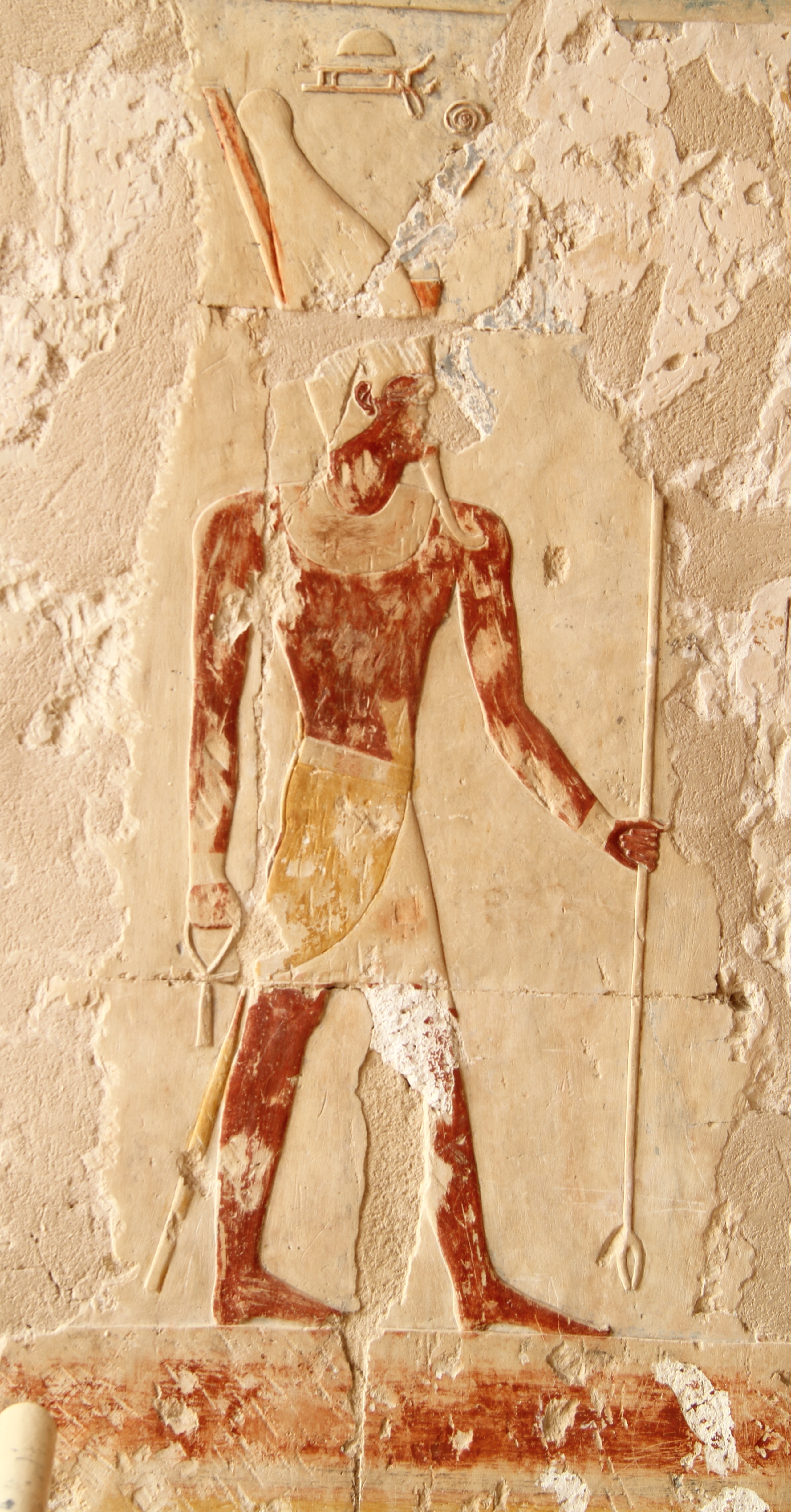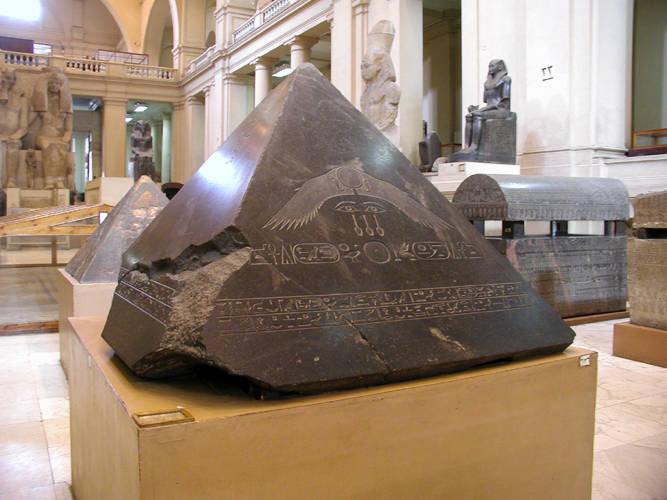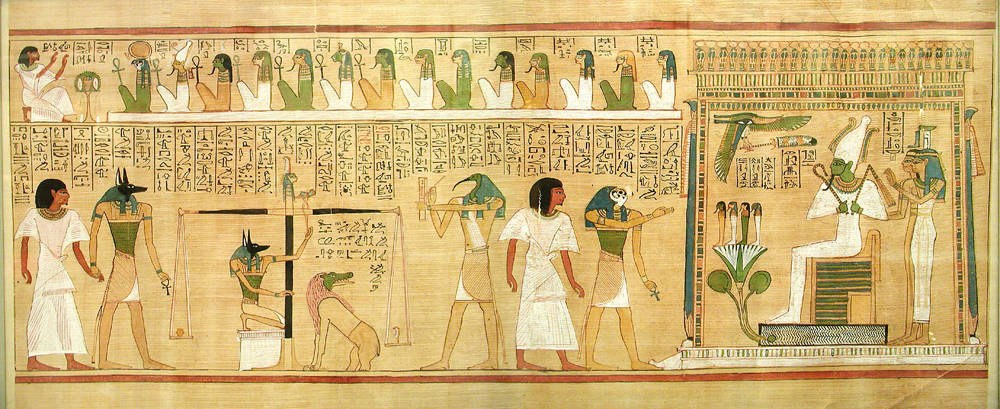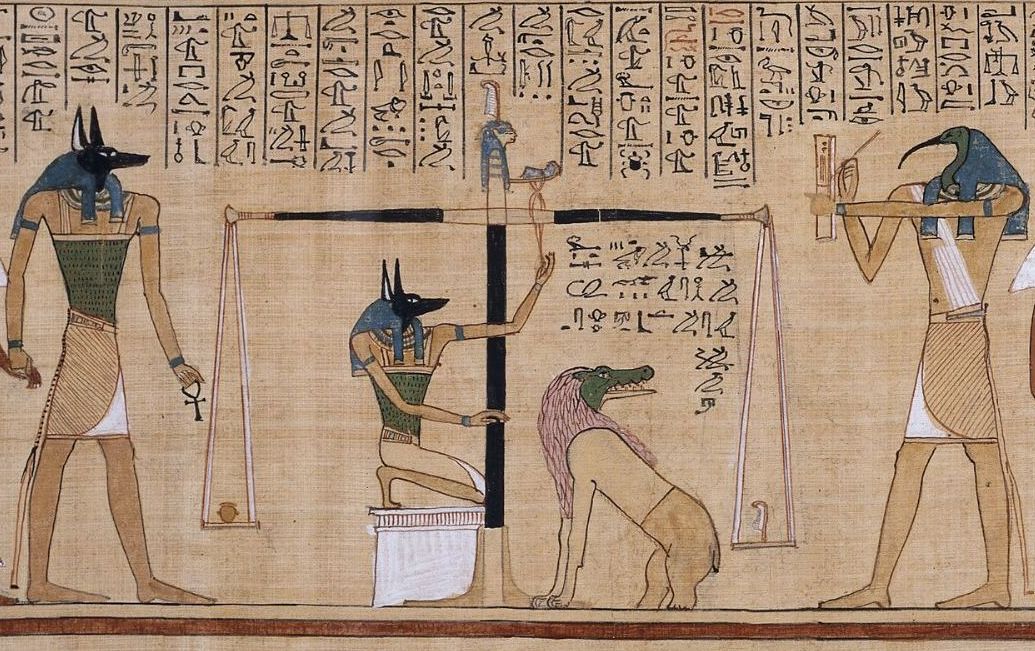|
Atum-re
Atum (, Egyptian: ''jtm(w)'' or ''tm(w)'', ''reconstructed'' ; Coptic ''Atoum''), sometimes rendered as Atem or Tem, is an important deity in Egyptian mythology. Name Atum's name is thought to be derived from the verb ''tm'' which means 'to complete' or 'to finish'. Thus, he has been interpreted as being the "complete one" and also the finisher of the world, which he returns to watery chaos at the end of the creative cycle. As creator, he was seen as the progenitor of the world, the deities and universe having received his vital force or ka. Origins Atum is one of the most important and frequently mentioned deities from earliest times, as evidenced by his prominence in the Pyramid Texts, where he is portrayed as both a creator and father to the king. Several writings contradict how Atum was brought into existence. Some state Atum was created by himself by saying his name, while others argue he came out from a blue lotus flower or an egg. Role In the Heliopolitan creation myt ... [...More Info...] [...Related Items...] OR: [Wikipedia] [Google] [Baidu] |
Heliopolis (Ancient Egypt)
Heliopolis (I͗wnw, Iunu or 𓉺𓏌𓊖; egy, I͗wnw, 'the Pillars'; cop, ⲱⲛ; gr, Ἡλιούπολις, Hēlioúpοlis, City of the Sun) was a major city of ancient Egypt. It was the capital of the 13th or Heliopolite Nome of Lower Egypt and a major religious centre. It is now located in Ayn Shams, a northeastern suburb of Cairo. Heliopolis was one of the oldest cities of ancient Egypt, occupied since the Predynastic Period.. It greatly expanded under the Old and Middle Kingdoms but is today mostly destroyed, its temples and other buildings having been scavenged for the construction of medieval Cairo. Most information about the ancient city comes from surviving records. The major surviving remnant of Heliopolis is the obelisk of the Temple of Ra-Atum erected by Senusret I of Dynasty XII. It still stands in its original position, now within Al-Masalla in Al-Matariyyah, Cairo. The high red granite obelisk weighs 120 tons (240,000 lbs) and is believed to be the ... [...More Info...] [...Related Items...] OR: [Wikipedia] [Google] [Baidu] |
Benben
In the creation myth of the Heliopolitan form of ancient Egyptian religion, Benben was the mound that arose from the primordial waters Nu upon which the creator deity Atum settled. The Benben stone (also known as a pyramidion) is the top stone of the pyramid. It is also related to the obelisk. Primeval mound In the Pyramid Texts, e.g. Utterances 587 and 600, Atum himself is at times referred to as "mound". It was said to have turned into a small pyramid, located in Heliopolis (Egyptian: ''Annu'' or ''Iunu''), within which Atum was said to dwell. Other cities developed their own myths of the primeval mound. At Memphis, the god Tatenen, an earth god and the origin of "all things in the shape of food and viands, divine offers, all good things", was the personification of the primeval mound. Benben stone The Benben stone, named after the mound, was a sacred stone in the egyptian temple, temple of Ra at Heliopolis (Egyptian: ''Annu'' or ''Iunu''). It was the location on which the f ... [...More Info...] [...Related Items...] OR: [Wikipedia] [Google] [Baidu] |
Diurnal Motion
Diurnal motion (, ) is an astronomical term referring to the apparent motion of celestial objects (e.g. the Sun and stars) around Earth, or more precisely around the two celestial poles, over the course of one day. It is caused by Earth's rotation around its axis, so almost every star appears to follow a circular arc path, called the diurnal circle, often depicted in star trail photography. The time for one complete rotation is 23 hours, 56 minutes, and 4.09 seconds – one sidereal day. The first experimental demonstration of this motion was conducted by Léon Foucault. Because Earth orbits the Sun once a year, the sidereal time at any given place and time will gain about four minutes against local civil time, every 24 hours, until, after a year has passed, one additional sidereal "day" has elapsed compared to the number of solar days that have gone by. Relative direction The relative direction of diurnal motion in the Northern Celestial Hemisphere are as follows: * Facing nort ... [...More Info...] [...Related Items...] OR: [Wikipedia] [Google] [Baidu] |
Post-existence
The afterlife (also referred to as life after death) is a purported existence in which the essential part of an individual's identity or their stream of consciousness continues to live after the death of their physical body. The surviving essential aspect varies between belief systems; it may be some partial element, or the entire soul or spirit of an individual, which carries with it and may confer personal identity or, on the contrary, nirvana. Belief in an afterlife is in contrast to the belief in oblivion after death. In some views, this continued existence takes place in a spiritual realm, while in others, the individual may be reborn into this world and begin the life cycle over again, likely with no memory of what they have done in the past. In this latter view, such rebirths and deaths may take place over and over again continuously until the individual gains entry to a spiritual realm or otherworld. Major views on the afterlife derive from religion, esotericism an ... [...More Info...] [...Related Items...] OR: [Wikipedia] [Google] [Baidu] |
Pre-existence
Pre-existence, preexistence, beforelife, or premortal existence, is the belief that each individual human soul existed before mortal conception, and at some point before birth enters or is placed into the body. Concepts of pre-existence can encompass either the belief that the soul came into existence at some time prior to conception or the belief that the soul is eternal. Alternative positions are traducianism and creationism, which both hold that the individual human soul does not come into existence until conception. It is to be distinguished from preformation, which is about physical existence and applies to all living things. Ancient Greek thought Plato believed in the pre-existence of the soul, which tied in with his innatism. He thought that we are born with knowledge from a previous life that is subdued at birth and must be relearned. He saw all attainment of knowledge not as acquiring new information, but as remembering previously known information. Baha'i Faith Bah ... [...More Info...] [...Related Items...] OR: [Wikipedia] [Google] [Baidu] |
Serpent (symbolism)
The serpent, or snake, is one of the oldest and most widespread mythological symbols. The word is derived from Latin ''serpens'', a crawling animal or snake. Snakes have been associated with some of the oldest rituals known to mankind and represent dual expression of good and evil. In some cultures, snakes were fertility symbols. For example, the Hopi people of North America performed an annual snake dance to celebrate the union of Snake Youth (a Sky spirit) and Snake Girl (an Underworld spirit) and to renew the fertility of Nature. During the dance, live snakes were handled, and at the end of the dance the snakes were released into the fields to guarantee good crops. "The snake dance is a prayer to the spirits of the clouds, the thunder and the lightning, that the rain may fall on the growing crops." To the Hopi, snakes symbolized the umbilical cord, joining all humans to Mother Earth. The Great Goddess often had snakes as her familiars—sometimes twining around her sacred staff ... [...More Info...] [...Related Items...] OR: [Wikipedia] [Google] [Baidu] |
Chaos (cosmogony)
Chaos ( grc, χάος, kháos) is the mythological void state preceding the creation of the universe (the cosmos) in Greek creation myths. In Christian theology, the same term is used to refer to the gap or the abyss created by the separation of heaven and earth. Etymology Greek ''kháos'' () means 'emptiness, vast void, chasm, abyss', related to the verbs ''kháskō'' () and ''khaínō'' () 'gape, be wide open', from Proto-Indo-European ', cognate to Old English ''geanian'', 'to gape', whence English ''yawn''. It may also mean space, the expanse of air, the nether abyss or infinite darkness.Lidell-Scott, ''A Greek–English Lexiconchaos/ref> Pherecydes of Syros (fl. 6th century BC) interprets ''chaos'' as water, like something formless that can be differentiated. ''Chaoskampf'' The motif of ''Chaoskampf'' (; ) is ubiquitous in myth and legend, depicting a battle of a culture hero deity with a ''chaos monster'', often in the shape of a serpent or dragon. Parallel concepts ... [...More Info...] [...Related Items...] OR: [Wikipedia] [Google] [Baidu] |
Book Of The Dead
The ''Book of the Dead'' ( egy, 𓂋𓏤𓈒𓈒𓈒𓏌𓏤𓉐𓂋𓏏𓂻𓅓𓉔𓂋𓅱𓇳𓏤, ''rw n(y)w prt m hrw(w)'') is an ancient Egyptian funerary text generally written on papyrus and used from the beginning of the New Kingdom (around 1550 BCE) to around 50 BCE. The original Egyptian name for the text, transliterated ''rw nw prt m hrw'', is translated as ''Book of Coming Forth by Day'' or ''Book of Emerging Forth into the Light''. "Book" is the closest term to describe the loose collection of texts consisting of a number of magic spells intended to assist a dead person's journey through the ''Duat'', or underworld, and into the afterlife and written by many priests over a period of about 1,000 years. Karl Richard Lepsius introduced for these texts the German name ''Todtenbuch'' (modern spelling ''Totenbuch''), translated to English as Book of the Dead. The ''Book of the Dead'', which was placed in the coffin or burial chamber of the deceased, was part of a trad ... [...More Info...] [...Related Items...] OR: [Wikipedia] [Google] [Baidu] |
Khepri
Khepri (Egyptian: ''ḫprj,'' also transliterated Khepera, Kheper, Khepra, Chepri) is a scarab-faced god in ancient Egyptian religion who represents the rising or morning sun. By extension, he can also represent creation and the renewal of life.van Ryneveld, Maria M. ''The Presence and Significance of Khepri in Egyptian Religion and Art'', University of Pretoria (South Africa), Ann Arbor, 1992''. . Symbolism Khepri (''ḫprj'') is derived from the Egyptian language verb ''ḫpr,'' meaning to "develop", "come into being", or "create".Wilkinson, Richard H. (2003). ''The Complete Gods and Goddesses of Ancient Egypt''. Thames & Hudson. pp. 230–233 The god was connected to and often depicted as a scarab beetle (''ḫprr'' in Egyptian). Young dung beetles, having been laid as eggs within the dung ball, emerge from it fully formed and thus were considered to have been created from nothingness.Liszka, Kate. “Scarab Amulets in the Egyptian Collection of the Princeton University Art M ... [...More Info...] [...Related Items...] OR: [Wikipedia] [Google] [Baidu] |
Solar Deity
A solar deity or sun deity is a deity who represents the Sun, or an aspect of it. Such deities are usually associated with power and strength. Solar deities and Sun worship can be found throughout most of recorded history in various forms. The Sun is sometimes referred to by its Latin name ''Sol'' or by its Greek name '' Helios''. The English word ''sun'' derives from Proto-Germanic *''sunnǭ''. Overview Predynasty Egyptian beliefs attribute Atum as the Sun god and Horus as god of the sky and Sun. As the Old Kingdom theocracy gained influence, early beliefs were incorporated into the expanding popularity of Ra and the Osiris-Horus mythology. Atum became Ra-Atum, the rays of the setting Sun. Osiris became the divine heir to Atum's power on Earth and passed his divine authority to his son, Horus. Other early Egyptian myths imply that the Sun is incorporated with the lioness Sekhmet at night and is reflected in her eyes; or that the Sun is found within the cow Hathor during t ... [...More Info...] [...Related Items...] OR: [Wikipedia] [Google] [Baidu] |
Old Kingdom
In ancient Egyptian history, the Old Kingdom is the period spanning c. 2700–2200 BC. It is also known as the "Age of the Pyramids" or the "Age of the Pyramid Builders", as it encompasses the reigns of the great pyramid-builders of the Fourth Dynasty, such as King Sneferu, who perfected the art of pyramid-building, and the kings Khufu, Khafre and Menkaure, who constructed the pyramids at Giza. Egypt attained its first sustained peak of civilization during the Old Kingdom, the first of three so-called "Kingdom" periods (followed by the Middle Kingdom and New Kingdom), which mark the high points of civilization in the lower Nile Valley. The concept of an "Old Kingdom" as one of three "golden ages" was coined in 1845 by the German Egyptologist Baron von Bunsen, and its definition would evolve significantly throughout the 19th and the 20th centuries. Not only was the last king of the Early Dynastic Period related to the first two kings of the Old Kingdom, but the "capital", ... [...More Info...] [...Related Items...] OR: [Wikipedia] [Google] [Baidu] |
Masturbation
Masturbation is the sexual stimulation of one's own genitals for sexual arousal or other sexual pleasure, usually to the point of orgasm. The stimulation may involve hands, fingers, everyday objects, sex toys such as vibrators, or combinations of these. Mutual masturbation is masturbation with a sexual partner, and may include manual stimulation of a partner's genitals ( fingering or a handjob), or be used as a form of non-penetrative sex. Masturbation is frequent in both sexes and at any age. Various medical and psychological benefits have been attributed to a healthy attitude toward sexual activity in general and to masturbation in particular. No causal relationship is known between masturbation and any form of mental or physical disorder. In the Western world, masturbation in private or with a partner is generally considered a normal and healthy part of sexual enjoyment. Masturbation has been depicted in art since prehistoric times, and is both mentioned and discussed in ... [...More Info...] [...Related Items...] OR: [Wikipedia] [Google] [Baidu] |








